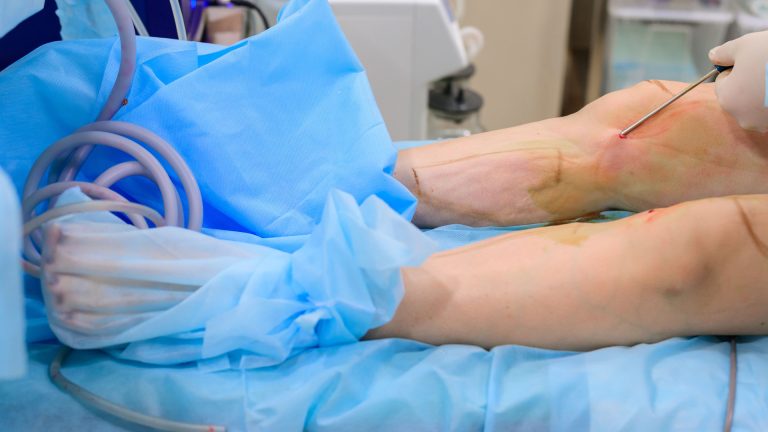Do You Need a Tummy Tuck or Liposuction? 8 Key Differences
Posted on: March 14, 2023
Table of Contents
- I. Introduction
- Difference #1: Target Areas
- Tummy Tuck Targets Lower Abdomen
- Liposuction Targets Specific Problem Areas
I. Introduction
Tummy tuck and liposuction are two popular cosmetic procedures used to improve the appearance of the abdomen. While they both involve removing excess fat, there are several key differences between them. This blog post will discuss 8 key differences between tummy tuck and liposuction so that you can make an informed decision about which procedure is best for you. We will cover the target areas, amount of fat removed, anesthesia used, recovery time, results, cost, and other factors to consider when deciding between the two.
Difference #1: Target Areas
A tummy tuck, or abdominoplasty, is a surgical procedure that removes excess fat and skin from the lower abdomen. It can also restore weakened or separated muscles in the abdominal wall. This procedure is typically performed on those who have loose skin due to pregnancy or weight loss.
Tummy Tuck Targets Lower Abdomen
The target area of a tummy tuck is the lower abdomen, which may include the entire abdomen, or just the area below the navel. The amount of fat removed depends on how much excess skin needs to be removed, but it usually ranges from 1-5 pounds. The goal is to create a flatter and firmer stomach.
Liposuction Targets Specific Problem Areas
Liposuction, also known as lipoplasty, is a surgical procedure used to remove excess fat from specific areas of the body. Unlike a tummy tuck which targets the entire lower abdomen, liposuction targets specific problem areas such as the thighs, hips, arms, neck, chin, and abdomen. The amount of fat removed during liposuction typically ranges from 1-5 pounds as well.
Difference #2: Amount of Fat Removed
A tummy tuck procedure typically removes a larger amount of fat than liposuction. This is because a tummy tuck is an invasive surgery that involves making an incision in the lower abdomen and removing excess skin and fat from the abdominal area. Liposuction, on the other hand, is a minimally-invasive procedure that uses suction to remove localized deposits of fat from targeted areas. It does not involve any surgical incisions or removal of skin.
Tummy Tuck Removes More Fat
Tummy tucks are usually recommended for individuals who have lost a large amount of weight and have excess skin as well as fat in the abdominal area. During a tummy tuck procedure, the surgeon will make an incision in the lower abdomen and then remove both excess skin and fat from the area. The amount of fat that can be removed during a tummy tuck depends on several factors, such as the individual’s overall health and body type.
Liposuction Removes Less Fat
Liposuction is typically recommended for individuals who have localized deposits of fat in specific areas, such as the thighs, buttocks, or abdomen. During liposuction, the surgeon will make small incisions in the targeted areas and then use suction to remove excess fat from those areas. The amount of fat that can be removed during liposuction depends on several factors, such as how much fat is present in the area and how easily it can be removed.
Difference #3: Anesthesia Used
Tummy Tuck Requires General Anesthesia
A tummy tuck requires general anesthesia. This means the patient will be put to sleep and unable to move during the procedure. This type of anesthesia is necessary for a tummy tuck because it is a major surgical procedure that involves cutting and reshaping the skin, muscles, and tissue of the abdomen. It is also used because it provides a greater level of comfort and safety for the patient during the procedure.
Liposuction Requires Local Anesthesia or Sedation
Liposuction requires either local anesthesia or sedation. Local anesthesia numbs only a specific area of the body, so the patient may be awake but unable to feel any pain in that area. Sedation puts the patient into a light sleep, so they are still able to respond to commands from their doctor but are not fully conscious. Sedation is often used if multiple areas of fat need to be removed during liposuction.
Difference #4: Recovery Time
The recovery time for a tummy tuck is generally much longer than that of liposuction. After a tummy tuck, patients may need to take up to two weeks off work, and should avoid strenuous activity for at least six weeks. The recovery period involves wearing a compression garment to help keep swelling and bruising down, as well as taking antibiotics to reduce the risk of infection. Pain medication may also be prescribed.
Tummy Tuck Recovery Time
The recovery time for a tummy tuck can vary from patient to patient. Generally, it takes about six weeks for most of the swelling and bruising to subside, and about three months before the patient can resume normal activities such as exercise. It is important that the patient follows their doctor’s instructions during recovery in order to ensure the best possible results.
Liposuction Recovery Time
The recovery time for liposuction is much shorter than that of a tummy tuck. Most patients are able to return to work within a few days after the procedure, although they should avoid strenuous activity or exercise for several weeks. Swelling and bruising will usually subside within two weeks, but it may take several months before the full results of the procedure are visible.
Difference #5: Results
Tummy Tuck Results Last Longer
A tummy tuck will produce more long-lasting results than liposuction. This is because a tummy tuck removes excess skin and fat from the abdomen, which can be difficult to remove through diet and exercise alone. Liposuction only removes fat cells, so if you gain weight after the procedure, the fat cells may return in other areas of your body.
Liposuction Results Are Not Permanent
Unlike a tummy tuck, liposuction does not remove excess skin or tighten muscles. As a result, liposuction results are not permanent and may require additional treatments to maintain their effects. Additionally, the amount of fat removed during liposuction is limited and may not provide the desired results.
Factors That Influence Results of Both Procedures
The outcome of both procedures depends on several factors such as age, skin elasticity, lifestyle habits, and overall health. Patients who maintain a healthy diet and exercise regularly will see longer lasting results than those who do not. Additionally, the skill level of the surgeon performing the procedure can also influence the outcome.
Difference #6: Cost
A. Cost of a Tummy Tuck Is Generally Higher Than Liposuction
The cost of a tummy tuck is generally higher than liposuction. This is because a tummy tuck requires more time and effort to perform, as well as more anesthesia and other medical supplies. Additionally, the recovery time for a tummy tuck is typically longer than that of liposuction, meaning more follow up visits and care are necessary for the patient.
B. Factors That Influence Cost of Both Procedures
There are various factors that influence the cost of both procedures. These include the complexity of the procedure, the type of anesthesia used, the location where the procedure will be performed, and the experience level of the surgeon performing it. Additionally, insurance coverage may also affect the overall cost of either procedure.
Conclusion
When deciding between a tummy tuck and liposuction, it is important to consider the 8 key differences. Tummy tucks target the lower abdomen while liposuction targets specific problem areas. Tummy tucks remove more fat than liposuction and require general anesthesia, while liposuction requires local anesthesia or sedation. Recovery time for a tummy tuck is longer than for liposuction. Results of a tummy tuck last longer than those from liposuction, and cost of a tummy tuck is usually higher. Factors that influence results and cost of both procedures should be taken into account when making your decision.




